Archive for the ‘Commonplace Book’ Category
A reread to help me jump into a new year and a new project. Steven Pressfield’s take on Resistance is some of the most useful teaching about writing I’ve ever encountered.
“I wake up with a gnawing sensation of dissatisfaction. Already I feel fear. Already the loved ones around me are starting to fade. I interact. I’m present. But I’m not.
I’m not thinking about the work. I’ve already consigned that to the Muse. What I am aware of is Resistance. I feel it in my guts. I afford it the utmost respect, because I know it can defeat me on any given day as easily as the need for a drink can overcome an alcoholic.
I go through the chores, the correspondence, the obligations of daily life. Again I’m there but not really. The clock is running in my head; I know I can indulge in daily crap for a little while, but I must cut it off when the bell rings.”
Affiliate links: Bookshop.org (supports independent bookstores) • Kindle
“Tell me some more about your valley,” she said to Moomintroll.
“It’s the most wonderful valley in the world,” he answered. “There are blue-trees with pears growing on them, and chatterfinches sing from morning till night, and there are plenty of silver poplars, which are wonderful for climbing—I thought of building a house for myself in one of them. Then, at night, the moon is reflected in the river, which tinkles over the rocks with a sound like broken glass, and pappa has built a bridge that is wide enough for a wheelbarrow.”
“Must you be so poetic?” said Sniff. “When we were in the valley you only talked about how wonderful other places were.”
“That was different,” said Moomintroll.
“But it’s true,” said Snufkin. “We’re all like that. You must go on a long journey before you can really find out how wonderful home is.”
—Tove Jansson, Comet in Moominland
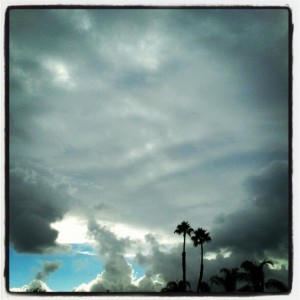
The black curagh working slowly through this world of grey, and the soft hissing of the rain gave me one of the moods in which we realise with immense distress the short moment we have left us to experience all the wonder and beauty of the world.
—The Aran Islands, J.M. Synge
This week Beanie and I reached the J. M. Synge episode of The Irish Identity. The quote above found me at the perfect time, as I neared the end of Emily St. John Mandel’s lovely Station Eleven, and on the day the President announced his intention to withdraw from the Paris Climate Agreement.
Even after the people of the south island, these men of Inishmaan seemed to be moved by strange archaic sympathies with the world. Their mood accorded itself with wonderful fineness to the suggestions of the day, and their ancient Gaelic seemed so full of divine simplicity that I would have liked to turn the prow to the west and row with them for ever.
“…I found the July days fly fast, and it was not until I felt myself confronted with too great pride and pleasure in the display, one night, of two dollars and twenty-seven cents which I had taken in during the day, that I remembered a long piece of writing, sadly belated now, which I was bound to do. To have been patted kindly on the shoulder and called “darlin’,” to have been offered a surprise of early mushrooms for supper, to have had all the glory of making two dollars and twenty-seven cents in a single day, and then to renounce it all and withdraw from these pleasant successes, needed much resolution. Literary employments are so vexed with uncertainties at best, and it was not until the voice of conscience sounded louder in my ears than the sea on the nearest pebble beach that I said unkind words of withdrawal to Mrs. Todd.”
—Sarah Orne Jewett, The Country of the Pointed Firs
On my mind constantly of late: notebooks, sketchbooks, art journals, and combinations thereof. Conversations are swirling in several of my circles—
• at Sketchbook Skool there is always lots of chatter about what people prefer to draw on and with;
• over at Wisteria & Sunshine, Lesley has been revisiting the topic of daybooks (especially handmade ones);
• Kortney is posting wonderfully enticing things about right-brain planning;
• Amy Ludwig Vanderwater is hosting a summer “Sharing Our Notebooks” project that I plan to participate in, soon as I get a chance…
Once a week I meet a small group of teenaged girls (one of them my Beanie) at a coffee shop to discuss literature while their younger siblings take piano lessons in the studio upstairs. This is hands-down one of the best hours of my week: meaty stories; lively analysis; word-collection; chitchat. A couple of weeks ago we ran off on a tangent of comparing one another’s notebooks. The conversation coincided with a similar thread at Wisteria & Sunshine, so I was primed. I’ve been using graph-style spiral-bound steno pads for the past year or so, with a modified bullet-journal method. (Chiefly the use of an index page at the front of each notebook—that was a game-changer for me.) But I was hankering after something less utilitarian-looking, and one of my lit girls had a new kraft-brown Moleskine that set me swooning. Back at home, I looked it up and it was exactly what I wanted. Slim paperback in the size I favor (Moleskine calls it “large” but it’s only 5×8), and—this was crucial—they offer a “squared” (graph-style) version.
I’ve used Moleskines before but mostly the Volant model with the bright solid-colored covers. So pretty on my shelf but you can’t really fold them back on themselves, and I don’t like writing on a double-page spread. That’s why I’ve mostly sighed and made do with spirals. But Moleskine’s Cahier model with a heavy paper cover is flexible enough for me to fold back. And I love the pocket in the back, such a nice touch.
Kraft paper is one of my favorite surfaces for decorating, so of course the cover cried out for some decoration. I started on the back in case I messed up. Still haven’t decided what I want to do on the front.
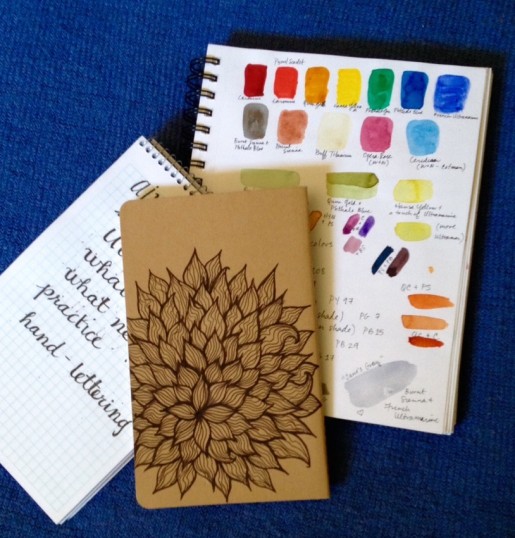
gridded steno notebook, kraft brown Moleskine Cahier journal, Canson Mixed Media Sketchbook
I love a skinny notebook not only because it fits easily in my bag, but because it fills up faster. I am mad for the fresh start. I had a few pages left in my May steno book but I craved a clean slate for June, so I’ve been using up the steno pages with hand-lettering practice.
I use my daily notebook for list-making, idea-sorting, story-outlining, note-taking…basically anything that involves words. Words + doodles, really: my “work” pages are always margined with crosshatching and basketweave and spirals and mushrooms…whatever. I used to try to keep things compartmentalized: one notebook for current book-in-progress; one for medical & insurance notes (I always seem to have volumes of these); one for quotes/commonplace book entries; one for to-do lists…but they always wound up melded together, and then I’d have three or four mishmash notebooks going at once, which was ridiculous. So I gave up and embraced my brain’s clear need to dump itself onto a page, melting-pot style, and now I let all those channels of thought intermingle. (Messily, much like the mingling of metaphors in that sentence.)
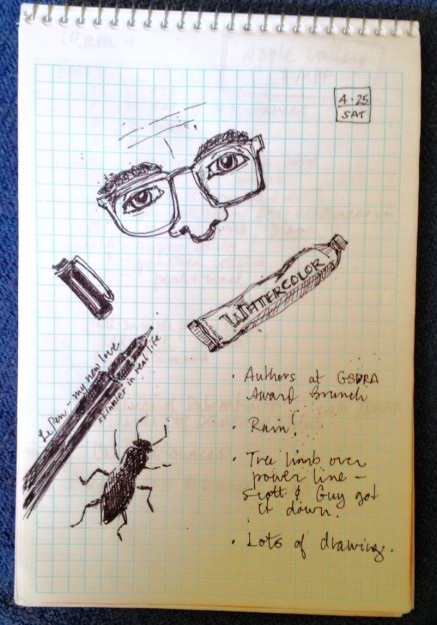
And these days my word-notebooks are overrun with drawings, too. I have a separate sketchbook—two, actually; a smaller (5×8) hardcover Moleskine that fits in my bag, and a larger (7×10) Canson mixed-media sketchbook that is my place to experiment with drawing techniques and paint. That’s where I do my Sketchbook Skool assignments—it’s my it’s okay to screw up place. Consequently, it sees way more action than the Moleskine sketchbook, which I pretty much only use when I’m 1) away from home and 2) feeling unobtrusive enough to draw in public. I don’t mind kids looking over my shoulder but I’m way too shy about my work to want adults eyeballing it in progress.
Interestingly, the Canson Mixed Media Sketchbook is the one that got a thumbs-down from Roz Stendahl (THE source of in-the-field info on all things art supply), and when I read her review I had a major light-bulb moment: Ohhhh, so you mean the paper isn’t supposed to buckle when I paint? This Canson (I’m in my second one now) is the only sketchbook I’ve ever painted in, so I thought that’s just how it went, unless you bought one with watercolor paper. Roz’s report clued me in to the possibility that the book I picked (entirely because it was on sale at Michael’s) may not perform as satisfactorily as other brands. I’m nearing the end of this one (you guys!!! I’ve filled two whole sketchbooks with drawings!!) and may take Roz’s recommendation and try a Strathmore Journal Series’ Mixed Media book next time. Does Michael’s sell them, I wonder? Got another coupon burning a hole…
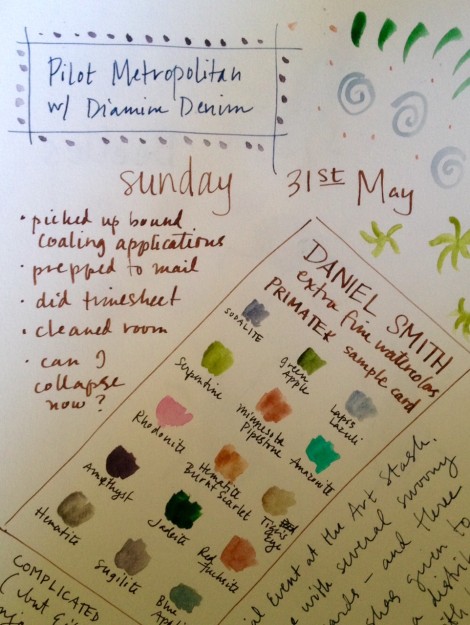
bad phone photo; can’t be bothered to scan
Okay, so I was saying that in theory I have the sketchbook(s) for, well, sketching, and the notebook for all the word things, but the truth is that ever since I started working on my drawing skills last fall, I’ve got rough sketches running wild all over my word-notebooks. Again, this is something I’ve just decided to be at peace with. So much of my work involves a rigorous process of polishing and structure, and I think perhaps my mind really needs a place to be messy and unfiltered, a place to set itself down in raw form. It’s like a test kitchen for my thoughts, I guess. This is where the index is so invaluable: it allows me to quickly locate the notes from that Very Important Phone Call without having to hunt through pages of nonsense. I try to update the index at least once a week—just a mild leaf-through to note down the page numbers on which I have recorded important information. I number the pages of my notebooks in the bottom right corner, about ten pages at a time. I like to write my to-do lists on a Post-It that can travel from page to page. As each task is crossed off, I jot it down in the notebook for a record of what I’ve done.
Since the ugly steno books all look the same on the shelf, I would run a highlighter down the sides of the pages, a different color for each new book. But so far the kraft Moleskine is serving beautifully, and I doubt I’ll go back to the steno grids. I might use a bit of Washi tape on the spine to differentiate the Moleskines on the shelf, once they’re filled.
***
Back to my coffee-shop girls. We had so much fun that day, comparing notebook preferences, that we decided to all bring our sketchbooks the following week. Which was truly delightful—what a treasure, this look at the outpouring of creativity from these girls. Beautiful design work (I mean really breathtaking, some of it), whimsical drawings (much more skilled than mine), and illustrated quotes, and just so much wonder, so much evidence of curious minds sifting the world. I felt really honored to have this work shared with me. We are nearing the end of the topics we charted for our class, but the girls begged me to keep going through the summer. So we’re thinking of spending a few weeks on sketching and notebooking. I have all sorts of ideas for things we can do together—heavily Lynda Barry-influenced, naturally, because who better to guide you through an exploration of all the things a sheet of paper can become?
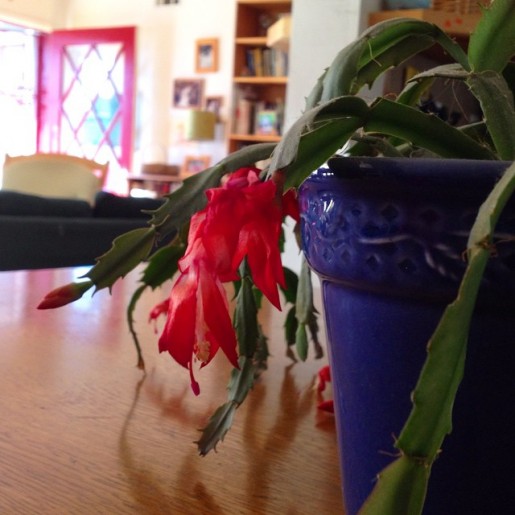
Ours is in bloom this very day, as it happens
“Our Christmas cactus has predictably bloomed each December for three decades and some years when it has been colder for longer, as is the case this year, it often blooms more than once a year. Our Christmas cactus is alive and growing 365 days of the year, most of which it is rarely seen by me but only looked at.”
That’s Owen Swain in his post “Blooming Cactus / blooming an illustrated life / and, what I learned in Sketchbook Skool.”
In his drawing of the cactus, he includes a quote which sent me immediately dashing for my commonplace book (which is to say, this blog).
“While drawing grasses I learn nothing ‘about’ grass, but wake to the wonder of this grass and its growing, to the wonder that there is grass at all.”
—Frederick Franck
That. Yes. Exactly. Or at least, I suppose I would say I learn something about grass when I’m drawing it, I learn something about everything I look at closely. But that kind of learning is implied in the quote. I get what he means by ‘about.’ And yes, the waking to the wonder of a thing by observing it quietly, moving your pen along its paths, or by writing a poem about it (“This grasshopper, I mean—/ the one who has flung herself out of the grass,/ the one who is eating sugar out of my hand, who is moving her jaws back and forth instead of up and down—/ who is gazing around with her enormous and complicated eyes…”)*; even, I daresay, by blogging about it—the combined act of observing, pondering, and then expressing, in word or line—these endeavors shift your relationship with the humble object; they awaken you to the wonder the thing actually is.
The very first revelation that struck me about drawing, way back in college during a too-brief foray into sketching, was the passage in the Betty Edwards book Drawing on the Right Side of the Brain in which one of Betty’s students mentioned that after she began trying to draw faces, “every face I looked at seemed beautiful to me.” I have written before about the enormous impact that statement had on me, not just in relation to drawing but to an overall view of life.
The drawing lessons taught her to really look at people, and when she did, she saw beauty everywhere.
I know I’m going all over the place here, but in my mind these things are all connected: this way of really looking, really seeing, noticing what is interesting and important and even beautiful about things many people whisk by without noticing. And what I can do for my children is refuse to fill up their lives with things they must patiently endure until a better moment comes. I can savor the moments as they happen, and give them the time and space to find what’s interesting and beautiful in every face the world shows them.
As I was writing that last sentence, Beanie appeared in front of me with a big smile and a present: a bracelet made of safety pins linked together, each pin shining with green and blue beads. “It’s for you, Mommy,” she breathed, so proud and excited. “Jane showed me how.” How patiently (the good kind of patience) she must have worked to slide all those beads in place.
I never noticed before what a work of art a safety pin is!
I’ve written so many times on this blog about how my approach to education is to keep the focus on the process, not the product. The lesson is renewed for me every time I take pencil in hand and try to capture the lines of a thing on my page. In the end, it doesn’t matter at all how my drawing ‘turns out.’ The magic is in the doing.
*From “The Summer Day” by Mary Oliver
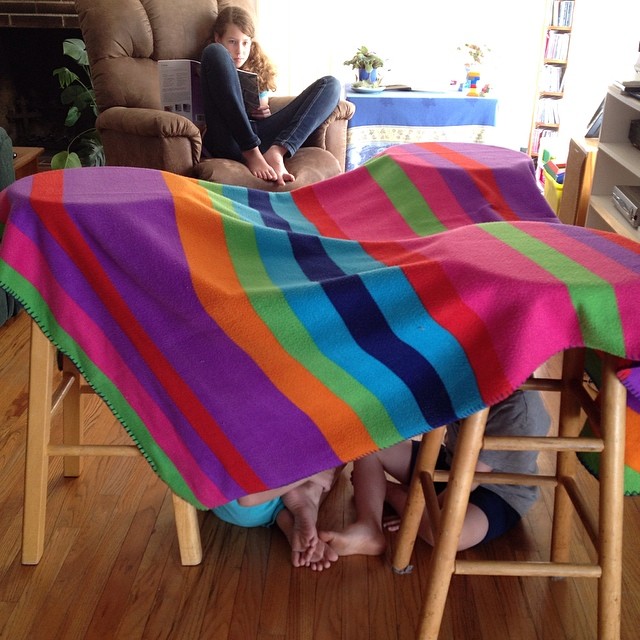
You know how you have that friend you used to talk to on the phone all the time, every day practically, so that even though you lived hundreds of miles apart, you were totally up on all the daily details of each other’s lives? And then along comes a busy week, maybe two, and you play a few rounds of phone tag, and suddenly there’s SO MUCH to catch up on that you know you’re going to need an hour, probably more, who are we kidding, and so you’re both waiting for a nice long chunk of time and meanwhile more life is happening and you’re never ever going to be able to catch each other up on all of it? Yeah, that’s how I’m feeling about my book log today. 🙂
For a few weeks there I was trotting along at such a nice clip, recording everything—not only books finished, which I’ve been faithfully logging since 2008, but fragments and sections of books, history and science chapters read to the kids, picture books, substantive internet articles, even individual poems. I’ve never kept track of my reading to such a granular degree before, and I was really enjoying it—both as a chronicle of the many branchings of my interests, and as a somewhat, for me, revelatory indication of the sheer amount of reading, challenging and otherwise, that I was doing all along but somehow not “counting.” Sigh, I only read two books this month, I might think, looking a year from now at my GoodReads tally for April 2014, forgetting the quantities of poetry I devoured that month (just no complete books of poetry, so they don’t qualify for a GR entry), the hundred-odd pages of mid-19th century American history and 17th-century science my girls and I tackled together, the Scientific American articles, the half a novel that didn’t hold me, the five or six opening chapters I sampled on Kindle, the dozens of picture books enjoyed with my younger three, the lecture transcripts, the Damn Interesting articles, the AV Club reviews. Of course it all counts. It all goes to the shaping of me, the stretching of me. My old book log, the finished-books-only kind, presents a comically, unrecognizably skewed picture. Presents this skewed picture to me, I mean—I’m not supposing that anyone else is troubling themselves about it 😉 —but future me will be much hazier about what riches were crammed in between those gaps in the record, the blank spaces between The Tuesday Club Murders and The Wheel on the School.
I’ll want, you know, to remember how that April (this April) was the month of Donne and Herbert, and of The Secret Garden, and of The Little Fur Family and The Americans (the TV show, not the James novel) and Beginning Theory—how way led to way, and reading up on Donne turned into teaching a poetry class, and how things we were reading in The Story of Science kept cropping up on the new Cosmos the very next night, and vice versa.
Until I began the granular logging in March (was it March?), I hadn’t realized how much reading was happening in the margins. Then I missed a day, and the next day there was more to catch up on, and so on and so on, and there went April. All this to say I’m going to start over (again) and see how long I can keep it up this time—and if I miss a day, I’ll let it go, like a balloon floating away into the sky, and not lose hold of the next day’s balloon in an attempt to retrieve the first.
(But if I remember what color the lost balloons were, I can say so. I remember some of yesterday’s balloons.)
Yesterday I happened upon a long piece called “Selling Henry James,” a Northwestern University professor’s account (in 1990) of his experience teaching a James seminar to undergraduates one quarter. Very enjoyable read. I got there via a Jamesian rabbit trail, which branched off a Virginia Woolf rabbit trail, which started actually last fall (and now I can’t remember why; didn’t log it!) and was rediscovered—oh, gosh, I’m losing track of the meanderings. I’ve been watching these Milton lectures at Open Yale, and I think it may have been something the professor said in one of those that made me jump back to Woolf, and then to Gilbert and Gubar’s Madwoman in the Attic, which I’ve never read til now—it took me most of last week to get through the two introductions and the first chapter, but I don’t mean “get through” in a negative sense, it was fiercely interesting reading, and amusing in that I realized, a little way in, that this is the text which most deeply informed the women’s lit class I took in college, though Madwoman itself was never assigned. That was the fall of 1988, fourteen years after Madwoman was published, and our professor was in her first year of teaching. I’ve had fun fitting these pieces of the puzzle together.
Earlier this week, still on the Woolf trail, simultaneous with Madwoman, I landed on this site and read the “Women’s Images in Literature” lectures in their entirety. Mostly for review, but like everyone I have gaps. Came away with yet more books to cram into the impossible queue.
The picture book Huck keeps asking for this week, and which I don’t mind reading over and over—the art is so lush, the colors (deep blue and gold) unusual, and the story sweet—is The Bear’s Song, which I was so glad to see make it to our list of finalists in last year’s CYBILs contest.
Rilla and I are nearly finished with The Secret Garden. Mrs. Sowerby had to conspire to send the children more food today, they’re starving all the time. I don’t want it to end.
The girls and I are on to Robert Burns now, today was “To a Mouse.” I always do “To a Mouse.”
We’ve returned to our French songs—we forgot about them for a while—”Promenons Nous Dans le Bois” and “Les Éléphants” from the on the French for Kids: Cha Cha Cha CD, mostly. And a lot of Robert Burns songs on YouTube, and (for no particular reason) this rendition of Waltzing Matilda.
The Henry James article left me in a James mood (no, I suppose the mood was already creeping over me and that’s why I googled it?) so last night at bedtime I barraged my Kindle with his books, and this morning I fell into The Turn of the Screw, which I’ve never read (I’ve only read Portrait of a Lady, Daisy Miller, and Washington Square) and can’t wait for bedtime tonight so I can (try to) return to it. The parentheses are because I’m still not managing nighttime reading, only crossword puzzles. Two nights ago I tried to read in bed. I remember nothing, but next morning when I opened the Kindle app on my phone, there was the E.M. Forster Collection open to his short story, “The Celestial Omnibus,” which I’d never read before. I fall asleep, and my finger hits the touchscreen, and the next day I find surprises, like this one. Forster was near the top of the library screen because of my binge in March. I read the Omnibus story and the next one, the one about the beech wood, “The Other Kingdom,” I think it’s called?, and then I had to go back and reread the last chapter of Howards End. (A part of me is always rereading the last chapter of Howards End.)
Before I end (with no conclusion), a James note and a James quote. The note is that, settling into (or being inexorably pulled into, I had no choice) Turn of the Screw and working, as one must, to keep up with the twistings of the sentences, I had this sudden rush of comfort—I don’t know how else to put it—of relief, really, in the realization that a thing about Henry James is that you can trust him to get you there in the end. To the end of the sentence, I mean. It’s going to have forty parts but in the end they will all hold together. I didn’t comprehend that the first time I read him, in my twenties. It’s like knowing a piece of music is going to resolve at the end of the phrase. The final chord will bring you back to the ground. Perhaps I’m a more patient reader now (now that I’m resigned to not getting through ALL THE BOOKS), or perhaps I’ve learned enough about craft over the years to know when a writer deserves my confidence. And I mean this observation only about syntax, about style—I don’t expect James to hand me the plot resolution I crave, he made that very clear at the start of our relationship (oh Isabel!)—but I find there’s an unlooked-for joy in trusting him on style.
And the quote: “Never say you know the last word about any human heart.”
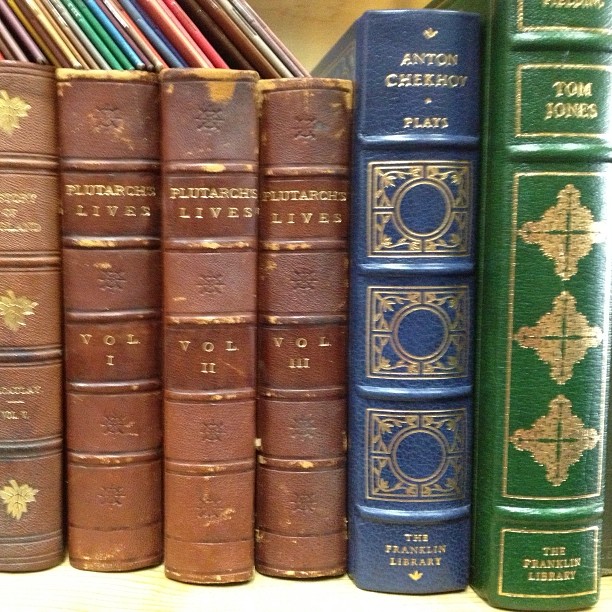
As long as I’m keeping a record of daily reading, I figured I ought to keep track of the academic lectures I’m taking in as well.
**Update: I’ve added a comment below explaining a bit about how these courses fit into my day. 🙂
***Update #2, 12/29/14*** Ack! I forgot to come back to this after March. This means I’ve forgotten things. Popped in today to add: A Day’s Read (The Great Courses), lecture 1: Kafka’s “The Country Doctor.”
Recently:
George Eliot: Intellect and Consciousness. Catherine Brown, Oxford.
Darwin and Design, Lecture 1. James Paradis, MIT.
American Novel Since 1945, Lectures 1-13. Amy Hungerford, Yale.
Introduction to Theory of Literature, Lectures 1-3, 5-6. Paul Fry, Yale.
In the past 18 months:
Modern Poetry, assorted lectures (I’m skipping around). Langdon Hammer, Yale.
The Civil War and Reconstruction Era. David Blight, Yale.
History 2D: Science, Magic, and Religion, Lectures 1-4. Courtenay Raia, UCLA.
MOOCs in progress with kids:
Moons, The Open University FutureLearn.
Shakespeare and His World (selected videos), University of Warwick, FutureLearn.
Live!: A History of Art for Artists, Animators and Gamers, California Institute of the Arts, Coursera.
Coursera courses on my own, in progress or last fall:
Scandinavian Film and Television. Multiple instructors, University of Copenhagen. Course in progress. Have watched vids for weeks 1-3 so far. Will probably not get all the way through before the course ends, as these lectures are a bit drier than others I’ve tried, but they’re quite interesting and I’m enjoying them—they just require a bit more focus because the visuals are very important (obviously).
Human Evolution: Past and Future. John Hawks, University of Wisconsin-Madison. Course just ended. Watched about half the videos. Loved how the professor traveled to various digs and fossil sites.
Plagues, Witches, and War: The Worlds of Historical Fiction. Bruce Holsinger, University of Virginia. Watched all videos, read several of the books. Great course!
Climate Literacy: Navigating Climate Change Conversations. Sarah Burch & Sara Harris, University of British Columbia. Did about 75% of the course—videos and readings. Showed several of the video lectures to my teens. I wish everyone I know would take this class. Hope it will be offered again.
Modern & Contemporary American Poetry. Al Filreis, University of Pennsylvania. Watched about half the videos, did corresponding readings. I adore this course and look forward to taking it again—in full this time—in the fall.
A Brief History of Humankind, Yuval Noah Harari, Hebrew University of Jerusalem. Lectures 1-4.
The Modern and the Postmodern. Michael Roth, Wesleyan University. Weeks 1-5. The reading load got to be more than I could juggle at that point in time but I very much enjoyed the lectures I watched.
CodeAcademy tutorials:
jQuery (23% completed)
Web Projects (89% completed)
HTML & CSS (completed)
***
There are so many appealing courses in literature alone (see this big list at Open Culture), not to mention all the classes I’d like to take in anthropology, history, art history, and various sciences. The Tolkien Professor’s Faerie and Fantasy class sounds especially fun! We were discussing these courses on Twitter this evening and a friend mentioned that she’d love to take one of these, but would be unlikely to finish. I seldom complete an entire course, as my Coursera record above demonstrates. But that doesn’t concern me; I consider each lecture I listen to a gain. I ran out of time to listen to all the Human Evolution lectures, but I learned a vast amount from the ones I did manage to watch. Ditto all the above. I’m exactly halfway through Amy Hungerford’s series on the modern American novel, and while I certainly hope to listen to the rest of the lectures, even if I don’t get back to them I’ve already gained a tremendous amount in terms of new knowledge and food for thought. This is unschooling for adults, and it’s exhilarating—learning as process, not product (that same philosophy that informs our homeschooling life).
There’s never any knowing—(how am I to put it?)—which of our actions, which of our idlenesses won’t have things hanging on it for ever.
—E.M. Forster, Where Angels Fear to Tread

 The War of Art by Steven Pressfield
The War of Art by Steven Pressfield







